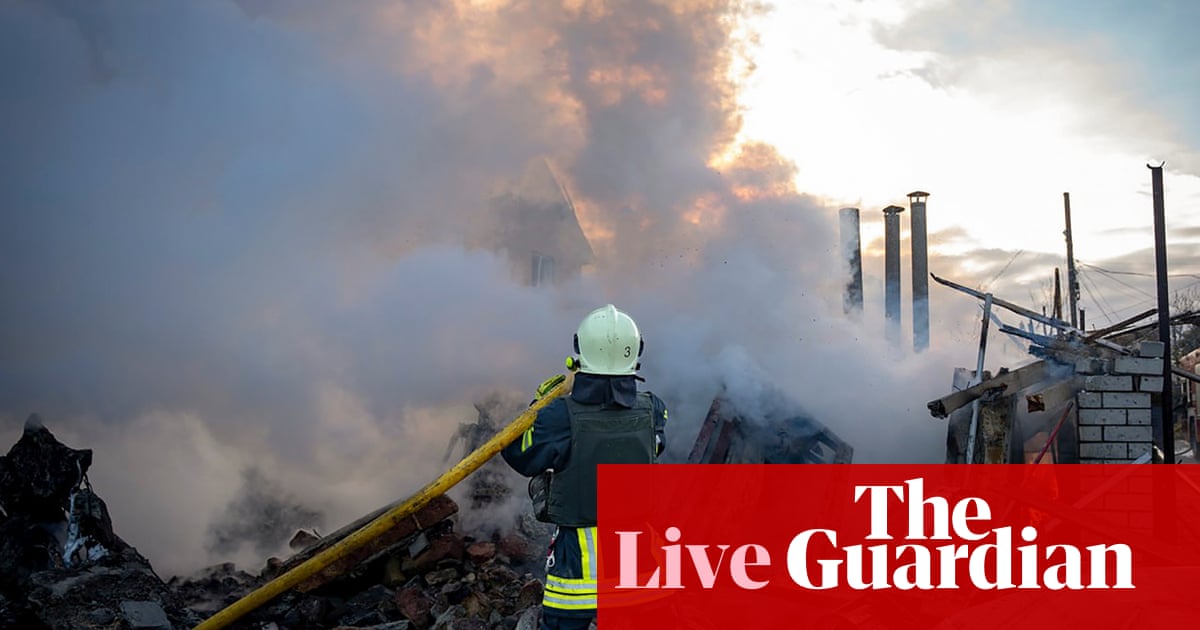Jordan Hatmaker knew something was wrong as soon as she tried to open her parachute. “You’re meant to look up to check: is it there? Is it square? And is it stable?” she says.
It was none of those things.
This was the second time that day that she and her skydiving coach had leapt from an aircraft 13,500ft above the fields and farmland of Suffolk, Virginia. Hatmaker was 35, a fairly experienced skydiver, just 10 jumps away from securing her skydiving licence.
“When you’re spinning around while being pulled to the ground, it’s hard to know exactly what’s happening. I was in my own world. All I was thinking about was how to get out of the situation. I felt oddly calm.
“I do remember seeing the ground coming towards me really quickly and I thought to myself: ‘This is going to hurt.’”
Hatmaker has always been a thrill-seeker. “I’ve always loved rollercoasters, zip-lining, jumping off cliffs into water, climbing mountains – all that stuff,” she says. Remarkably, she had never so much as broken a bone before that day in November 2021. “I never worried about safety; I always figured everything would be fine.”
After graduating from college, she began working for a defence contractor, selling equipment to the military. She first tried skydiving with a tandem jump in 2015 and immediately fell in love with the sport. “It’s been my dream to fly since I was a little kid – if somebody asked me what animal I would like to be, I would always say a bird. Being able to tackle something so daring gave me a great sense of confidence and pride.”
Friends encouraged her to get her licence. “It allows you to dive solo, which is a lot less expensive, and you can jump in any drop zone in the world. It’s around $5,000 (£3,900) to get your licence – and $3,000-5,000 to buy your own equipment – so it was a lot of money. But once you have it, it’s $25 a jump.”
Her other passion is dog rescue, and on the day of the accident, her brother came along to watch her jump, bringing her two dogs with him. “When he got there, he told me not to jump because he thought the vibes were off. I thought he was being ridiculous.” Dogs were not allowed in the hangar, so her brother had to leave.
On the ground, she was assigned a coach she hadn’t jumped with before, but that wasn’t uncommon; there were lots of coaches and skydivers would jump with whoever was available. They ran through “drills” – exercises or movements they would aim to replicate during freefall – then boarded the aircraft. The first jump went without a hitch and, as they ascended for the second time, Hatmaker had no qualms.
She and her coach jumped out separately, as they had planned, and began running through the drills they had practised on the ground. It was going well. She was “hitting all of them perfectly”.
“We had planned to match each other’s levels – so if she floated up, I was supposed to float up – and everything was good.” They continued in freefall for about a minute, then moved away from one another, so they could activate their parachutes without any risk of becoming tangled together.
She and her coach had agreed to freefall to 4,000ft; as her training progressed, she was able to deploy her parachute at increasingly lower altitudes, and this was the lowest she had ever gone. Hatmaker activated her pilot chute – a small preliminary parachute – and immediately knew something was wrong. The force of the inflation is designed to trigger the release of the main canopy, but instead, the pilot chute became wrapped around her leg in a malfunction known as a “horseshoe”.
She tried to untangle her leg but she was spinning and falling at about 70mph. “I thought, ‘OK, I’ll remove my shoe” – but I couldn’t because I’d double-knotted [the laces].” A shoe had come off during a previous jump, and she hadn’t wanted it to happen again.
If a parachute fails to deploy properly, the reserve parachute is triggered automatically. “I felt it jerk me upwards and I got control for a few seconds,” says Hatmaker. There was a paved runway below that she was desperate to avoid, and during this brief moment of stability she steered towards the grass.
Then she felt another jolt – her main parachute had finally “wiggled loose” from its bag and inflated. With hindsight, she says, this is where she may have made a “huge mistake”: she did not cut away the main canopy, which would have disconnected it from the harness (although it is possible it would have remained attached to her leg anyway). With both canopies deployed, there was a secondary malfunction, something Hatmaker had not heard of before, known as a “down plane”. The parachutes pull away from one another in opposite directions, streamlining the airflow, accelerating the skydiver’s descent rather than slowing it.
Even as Hatmaker spiralled towards the ground, she says the thought she might die never crossed her mind. At most, she thought she might break a leg – jeopardising her plans to climb to Mount Everest Base Camp three days later, a trip that had been a goal of hers for a couple of years.
In seconds, she crash-landed “a few football fields from where I should have been”.
After the crash, Hatmaker lay alone on the ground. She remembers the blades of grass in her mouth as she prayed out loud and screamed for help. Her pelvis was burning and she thought it was broken. But a bigger reality began to dawn. “I tried to get up and couldn’t move anything below my waist. I thought, ‘Oh my gosh, am I paralysed?’”
It took just a few minutes for some of the other skydivers and the drop zone manager to reach her, although it felt like longer. They were frantic as they called the ambulance.
“I was in the middle of nowhere so it took a good 30 minutes for an ambulance to come. It felt like for ever. The paramedics cut off my rig and tried to put me on a backboard gurney, but it was the most excruciating pain you could ever feel in your entire life.” When an air ambulance helicopter arrived, she didn’t realise at first that it was for her. “I thought, ‘Huh, that’s a helicopter’ – then I thought, ‘Whoa, I guess that must be for me!’”
It took around 10 minutes to reach Sentara Norfolk General Hospital, where her brother and her boyfriend of four months were the first to meet her.
Hatmaker was heavily sedated on arrival, and after five days in the ICU she was moved to the Intermediate Trauma floor. Friends started visiting. “Seeing their reactions – a lot of them cried – I was like, ‘Oh, wow, this must be bad.’” When her mum flew in from Seattle, Hatmaker began to grasp the severity of the situation. She knew she had broken her back, but it was only three weeks into her hospital stay that she realised the full extent of her injuries. She had broken several vertebrae, one of which had also crushed her spinal cord. It wasn’t until she was in the operating theatre that surgeons discovered she was leaking spinal fluid, which can cause complications including meningitis. In addition, she had hit the ground with her left leg first, causing her tibia to break near the ankle.
Soon after arriving at hospital she had extensive spinal surgery followed by two surgeries on her leg. “I was on oxygen for a long time and I had a back brace for months and months,” she says. “At one point, I had metal rods through my leg and ankle and foot.”
On the American Spinal Injury Association impairment scale – which runs from A to E, where A means complete paralysis – she was graded B. “The doctors didn’t know what the extent of my mobility would be. They don’t like to get your hopes up. But they said that it was a good sign I could move my toes after surgery.”
Eleven years earlier, she had had breast implants – and one of them “popped” as a result of the accident. “I had no idea,” says Hatmaker. “A plastic surgeon came to visit me [in hospital] and I just looked at him like: ‘This is the least of my worries right now.’”
There is no footage of Hatmaker’s accident. Sometimes coaches will wear a head camera to film the person they are jumping with, but Hatmaker later discovered her coach was not experienced enough to wear one. “You have to have done a certain number of jumps because it’s a little bit more dangerous – things can get caught on it,” she says.
She regrets her initial reaction at the scene of her crash. “When the flight paramedics came over to me, I said, ‘If I’m paralysed, just kill me.’” This isn’t how she feels now. “I’ve met so many people since that are paralysed and have amazing, fulfilling lives. But at the time I thought, ‘I don’t want to go on if this is going to be my life.’”
Parachute malfunctions are rare, and they do not always result in injury. According to the United States Parachute Association, there was one cut-away (indicating a malfunction) per 749 jumps in 2021; last year, there were just 10 civilian skydiving fatalities in the US, equating to 0.27 deaths per 100,000 jumps. Hatmaker had only experienced one less-than-perfect deployment previously, when her main parachute had twisted, but she knew how to correct it by performing bicycle kicks in the air. This time, the problem had been more complicated.
Throughout her hospital stay, Hatmaker remained defiantly optimistic. She says many of those who visited her were in disbelief at how well she was doing – both physically and mentally.
“I think having a positive outlook and attitude really helped me,” she says. Her sunny demeanour remains undiminished, and many of the photos from her time in hospital show her flashing a huge smile. “It was like a battle in my mind: one half of me was super worried that I wouldn’t be able to do everything that I love to do, but the other half of me was like, no, there’s no way.” She says she simply wouldn’t let herself believe her injuries could be life-changing. “I told myself – and I told everybody else – from the beginning that I was going to be back in action in a few months.”
She also credits her faith with spurring her on after the accident, and her belief that God has given her a second chance at life. “I think God kept me here for His purpose … my work here on Earth wasn’t yet complete. During hard times in recovery, I leaned on this notion and it encouraged me to keep going.” She still has no regrets about having made that jump. At least, she says, if she had been paralysed, she would have known she had “lived life to the fullest”.
She remained in her hospital bed for a month – less time than expected – and every day she was able to move her feet a little more. She passed the time by listening to true crime podcasts, watching TV and chatting to her nurses. “I was watching a lot of skydiving accident videos – I don’t know why I did that. I think I was trying to desensitise myself.”
Friends and family continued to visit, but medical staff also came in their droves, to see this rare patient who had survived a skydiving accident. “I was like a zoo exhibit!” she says. Eventually nurses had to put up a sign asking that she not be disturbed.
Hatmaker was discharged to her boyfriend’s house, about 20 minutes away from her own. “He’d made a room for me downstairs and he took care of me for months,” she says. She still didn’t have much control over her legs but within just a few weeks she was able to use a walker, then a wheelchair.
A home healthcare team came to visit and she started physical therapy. Seeing herself make progress reassured her “everything was going to be OK”. Within just three months of her accident, she was able to walk unaided.
Today, more than two years later, Hatmaker has finished her physical therapy, is off all her medication and is no longer under medical supervision, although she remains numb on her left side. She has gone back to work but believes that the accident, and the aftercare which she required, had an impact on her relationship; she and her boyfriend have since split up. She also started sharing her story online but found herself suffering from survivor’s guilt. “I met a lot of people who had the same injuries as me but who are paralysed, and I heard stories of people who had been in similar skydiving accidents, which didn’t end so well,” she says. “I felt like I wasn’t really worthy of sharing my story because I got off easy.”
Exactly one year after the accident, Hatmaker made it to Everest Base Camp. She went alone, as she had planned, accompanied only by her Sherpa guide. “My family definitely wanted me to go with somebody – and I even had a couple of people ask if they could go with me – but I said no. It was hard, but I was more determined than ever.” After all she had been through, the trip meant more to her than ever.
“It gave me a huge sense of accomplishment. It felt like I was regaining myself.” What’s next? “Oh, man. I really want to do the Dolomites in Italy and I’m interested in climbing some mountains in Chile and Ecuador.”
Remarkably, Hatmaker has made a return to skydiving, completing a tandem jump in October over the Moab desert in Utah. Was she nervous? “If I had been by myself, I would have felt apprehensive, but because I was strapped to a professional, I was completely fine,” she says, smiling. “I felt completely relaxed. I was just super happy to be up there.”



